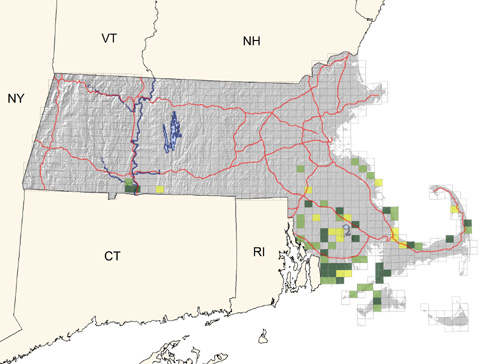Breeding Bird Atlases (BBA)
Find a Bird - BBA1
Breeding Bird Atlas 1 Species Accounts
Carolina Wren
Thryothorus ludovicianus
Egg Dates
April 17 to June 20
Number of Broods
one or two

Massachusetts represents the northern limit for the breeding range of this species, and in this state it is found nesting regularly only in the lower Connecticut River valley and the southeastern coastal plain from Norfolk County to Cape Cod. Curiously, it is absent on Nantucket but regular on Martha’s Vineyard. Naushon Island is the original site for the first recorded nesting in Massachusetts in 1901. The Carolina Wren has been slowly increasing its numbers and expanding its range over the last forty years and has been recorded breeding as far north as Essex County, but the expansion has not been as dramatic as for many other southern species—e.g., Northern Cardinal and Northern Mockingbird. Breeding was confirmed in Worcester County after the Atlas period.
The preferred habitats for this species are wet woodland with dense underbrush and uprooted trees, brushy thickets, grapevine tangles, farmland brush piles, and bushy swamp and stream edges. Nest locations are quite varied because the species shows considerable adaptation in its site selection. Nests are normally located fairly close to the ground under upturned roots of trees, in thick brush, or in holes in trees or stumps. The species is also well known for nesting in less traditional sites such as fence post holes, mailboxes, farm buildings, empty tin cans, wooden boxes, and old clothing left lying around inside barns and garages. Some birds have shown extreme tolerance for human activity close to the nest. Forbush reported Massachusetts nests in baskets inside buildings and in a beam recess of a sawmill. More recently, a pair in Worcester was observed building a nest on the rear wheels of a parked truck, and in East Longmeadow a pair nested in a paint bucket on a shelf 5 feet up in a garage (CNR).
The Carolina Wren is one of the few birds that will sing during all 12 months of the year, and pairs remain together during the winter. The song is a loud, ringing series of phrases of two to four notes repeated several times, usually with a strong accent on the first or second note. A variety of alarm, call, and scolding notes are produced, and occasionally the bird will mimic other species.
The nests are built with grass, leaves, rootlets, bark fibers, twigs, and moss, and are lined with fine grass, hair, and feathers. A nest in Dudley was a mass of twigs and ample leaf stems. The actual nest chamber was a nearly roofed-over hollow in the side of the pile 3 inches deep and lined with rabbit hair, webbing, and crumpled pieces of paper. Four to six eggs usually are laid, although as many as eight have been recorded. A nest in East Longmeadow contained only two eggs (CNR), one in Westboro contained four eggs on June 8 (EHF), and the Dudley nest contained at least six eggs (Meservey). Incubation lasts 12 to 14 days and is performed by the female. Both parents feed the young, and two broods may be reared. The young fledge in 12 to 14 days. The East Longmeadow nest contained two nestlings on July 10 (CNR). Nestlings hatched in the Dudley nest on May 5, and at least five young fledged on May 18 and 19 (Meservey). The original pair on Naushon Island was observed with young on July 7 (EHF).
Juvenal plumage is very similar to that of the adults but softer in texture and paler in color, with more white on the underparts. After the molt in August and September, the young are indistinguishable from the adults.
The Carolina Wren is present throughout the year within its breeding range. However, there is an annual fall dispersal, presumably of immatures, that results in Carolinas showing up in areas where they don’t nest. The magnitude of this dispersal varies from year to year and is most readily detected during Christmas Bird Counts. Because the wrens are vulnerable to winter mortality due to heavy snowfall, extreme low temperatures, or icing, the population in this northernmost part of its range fluctuates widely.
Map Legend and Data Summary
Atlas 1 data collected from 1975-1979


Note: fairly common in thickets of southeastern Massachusetts; steadily increasing in many lowland areas throughout the state
David L. Emerson



